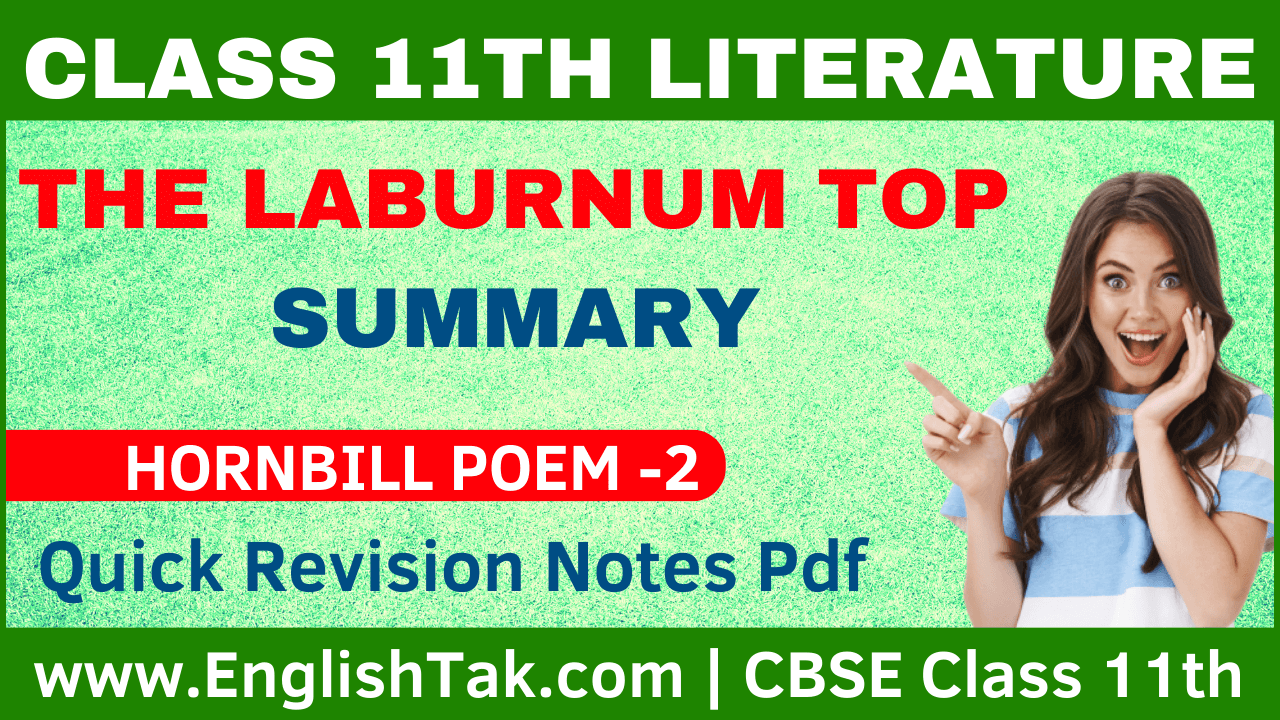![]()
The Laburnum Top Summary Class 11 English
Table of Contents
The Laburnum Top Summary – In this post, I am sharing The Laburnum Top Summary Class 11 which will be beneficial for all those who are going to appear at the Class 11th Final Exams.
THE LABURNUM TOP INTRODUCTION
The poem ‘The Laburnum Top’ is penned by Ted Hughes. It talks about the special connection between a Laburnum tree and a Goldfinch bird. The tree seems lifeless, like it’s asleep and yellow. But when the bird and her babies come, it comes to life. The bird makes a home in the tree, taking care of her babies there. However, when the bird flies away, the tree goes back to being quiet and still, like it’s not alive anymore.
ABOUT THE AUTHOR
Ted Hughes, whose real name was Edward J. Hughes, was an English poet. He’s known for writing poems that don’t get overly emotional and instead focus on the cleverness and fierceness of animals in sometimes sharp and disconnected lines.
While he was at Pembroke College in Cambridge, he became interested in folklore and anthropology, and you can see these interests in some of his poems. In 1956, he married the American poet Sylvia Plath. They moved to the United States in 1957, which is also the year his first book of poems, “The Hawk in the Rain,” was published. He wrote more books after that, including “Lupercal” in 1960, and “Selected Poems” in 1962, which he co-authored with Thom Gunn, another poet whose work is often linked with Hughes as a new direction in English poetry.
Hughes wrote lots of books for kids, and one of the famous ones is “The Iron Man” (1968), which was also turned into a movie in 1999. He also made books like “Remains of Elmet” (1979), where he talked about his childhood world. He often worked with photographers and artists on his books.
He took a play called “The Story of Vasco” by Georges Schehadé from French and turned it into an opera in 1974. Some parts of his writing were cut in the process. In 2009, a play based on Hughes’s original opera text was performed.
Hughes also did an adaptation of Seneca’s “Oedipus” in 1968, wrote nonfiction like “Winter Pollen” (1994), and translated works. He edited many poetry collections, like “The Rattle Bag” (1982) with Seamus Heaney.
In 2007, a book called “Letters of Ted Hughes,” which includes his correspondence with others, was published. He also wrote poems about animals, and a collection of those was released as “A Ted Hughes Bestiary” in 2014. In 1984, Hughes became Britain’s poet laureate.
The Laburnum Top Summary
In the poem, the poet talks about what he sees in the Laburnum tree. He starts by saying that the tree’s leaves are yellow. He also notices that the top of the tree is very quiet and doesn’t make any noise, even in September.
Because it’s now autumn, the tree doesn’t have any leaves left, and its seeds have fallen to the ground. What’s important to notice is that the poet uses the word ‘yellow’ to talk about both the color of the leaves and the sunlight. In this case, ‘yellow’ represents quietness, the end of life, and beauty. So, he uses this color to describe the whole scene really well.
Next, he sees that the tree, which seemed lifeless, changes when a goldfinch bird lands on it. The tree suddenly makes a chirping sound as the bird arrives. He compares how fast and alert the bird is to a lizard.
When the bird begins to move towards the thicker part of the branch, the baby birds in the nest start chirping and moving their wings. This makes the tree shake and tremble. So, the poet shows us two different situations when describing the tree. First, it was still and lifeless, and then it comes to life when the bird lands on it.
Later, the poet understands that the goldfinch bird and the tree are like the heart of her family. When she brings food for her baby birds, she goes to the end of another branch. The poet describes what the bird looks like, saying it has a face with stripes that are dark in color.
Later, the poet notices that the bird’s body is also yellow, so it matches the yellow leaves of the tree. When she reaches the end of the branch, she makes a lovely chirping sound. The poet compares this sound to a whisper as the bird flies away into the vast sky. So, after the bird goes away from the tree, the Laburnum tree becomes quiet and lifeless once more.
CONCLUSION OF THE LABURNUM TOP
In summary, “The Laburnum Top” teaches us about the special and caring bond between the tree and the bird, and how they are crucial to each other’s lives.
English For Class 11th
We’re Not Afraid to Die Summary
The Portrait of a Lady Summary
Discovering Tut the Saga Continues Word Meaning
The Portrait of a Lady Difficult Word





